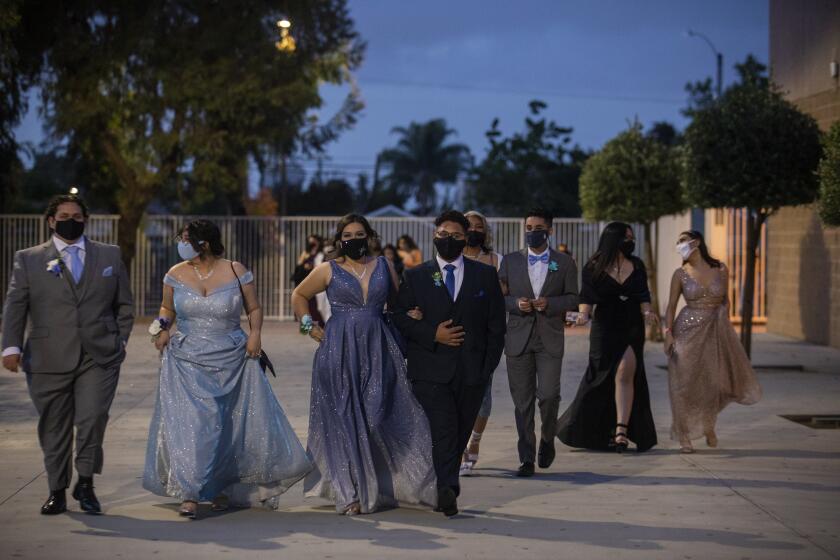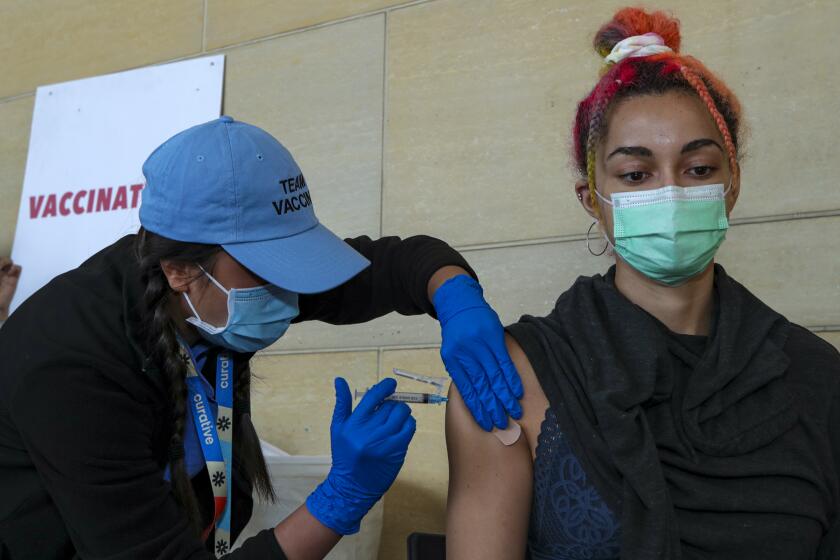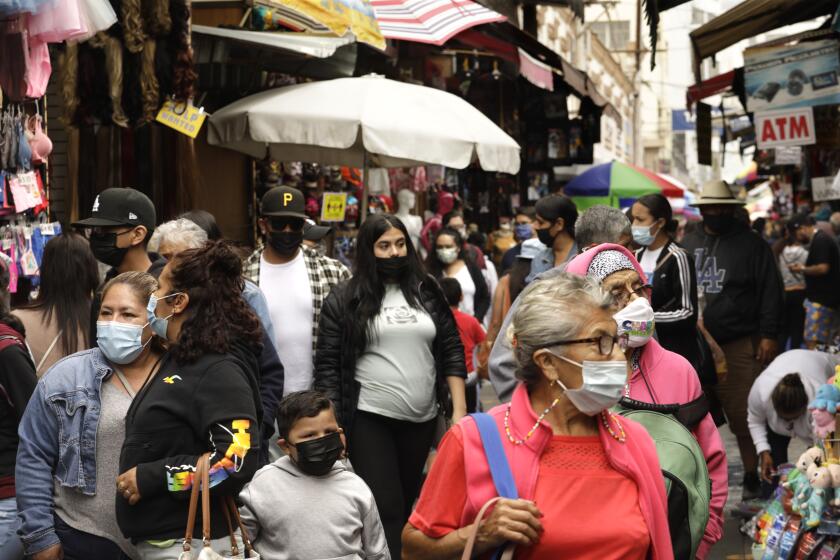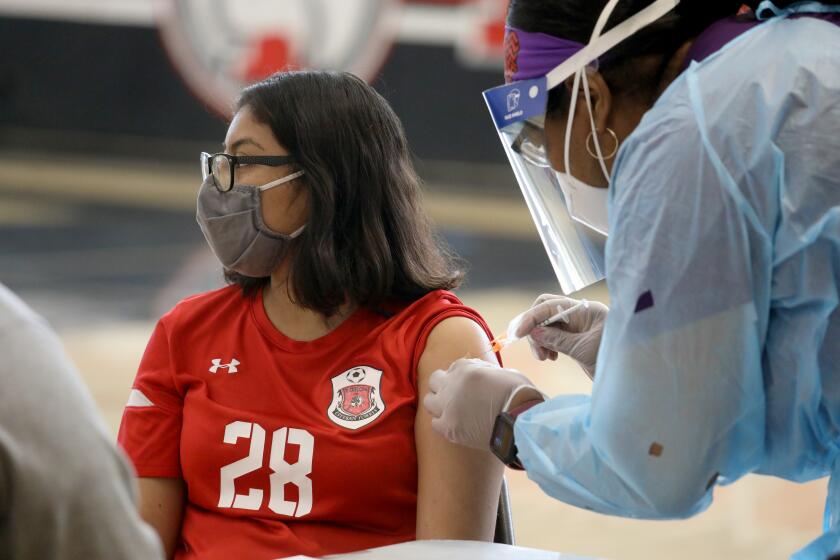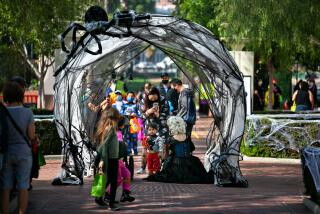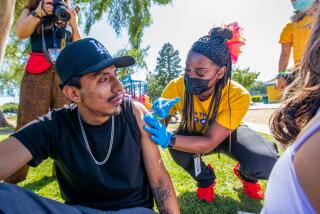California COVID-19 plunges to new lows, fueling hope big reopening won’t bring new surge
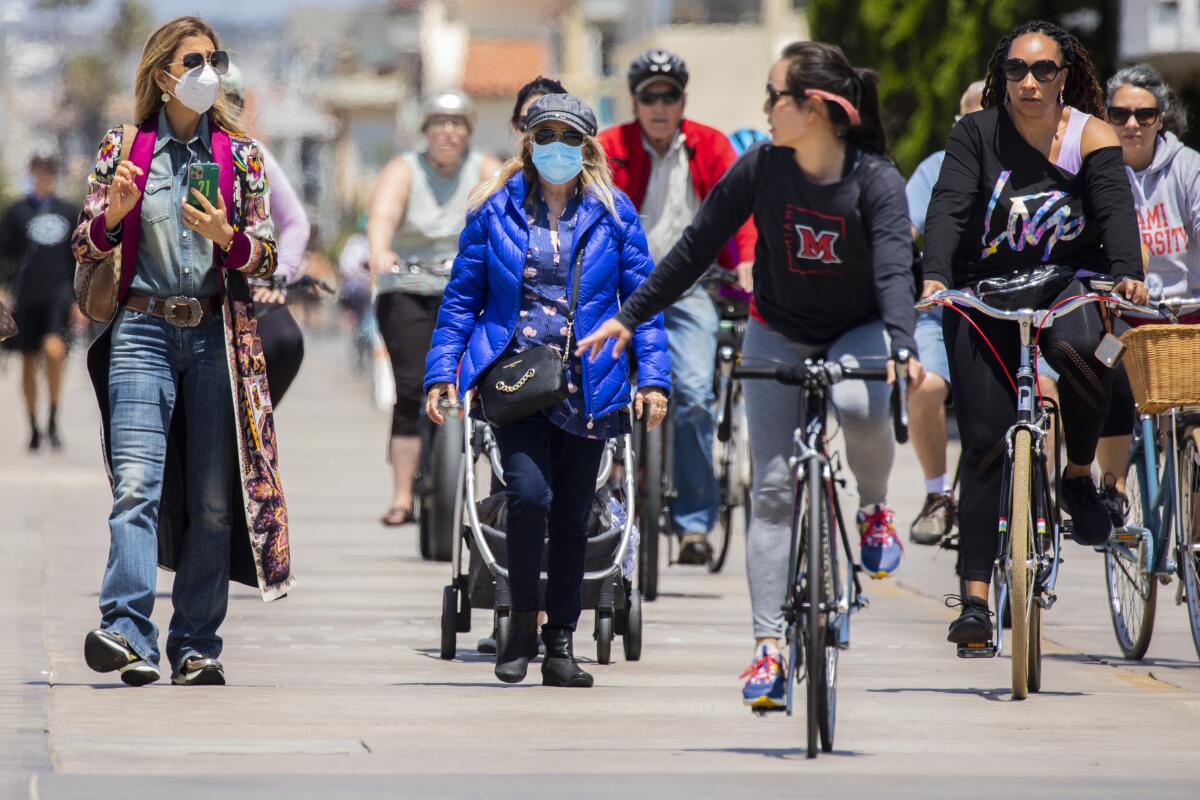
California will fully reopen its economy next Tuesday under remarkably favorable conditions, with the COVID-19 risk rapidly receding and new cases being reported at the lowest levels in 14 months.
The state has for several months recorded one of the lowest coronavirus infection rates in the country, a distinction that’s endured despite the end of many restrictions and the rise of new variants. The numbers and rapid rollout of vaccinations have given public health officials even more confidence that life can return to some semblance of normal without the horrific surges that thwarted California’s two previous attempts at reopening.
California has one of the highest rates of vaccinations in the nation, with 56% of residents of all ages — and 71% of adults — having received at least one dose of vaccine. Thirteen states now have at least 70% of their adults at least partially vaccinated, achieving a goal set by President Biden weeks before a July Fourth target.
That rollout of vaccines, especially in California’s most populous areas, have helped tame COVID-19 and tamped down transmission. Also a factor, especially in Los Angeles County, is the lingering immunity of many people who survived COVID-19 during the devastating surges in the last 15 months.
At its peak in January, the state was reporting 45,000 coronavirus cases a day. Now, California is reporting an average of fewer than 1,000 new coronavirus per day over the most recent seven-day period, according to data compiled by The Times.
The last time case counts were this low was March 31, 2020 — when the pandemic was just beginning to roar to life and testing was so limited that many infections likely went undetected.
That isn’t the case this time around. California’s latest seven-day average of 990 new coronavirus cases per day comes even as roughly 129,000 tests were conducted daily over that same period, Times’ data show. In the late spring of 2020, the earliest time that reliable data were available, there were only about 50,000 tests conducted daily.
COVID-19 hospitalizations are now at the lowest levels since California began systematically tracking that statistic on March 30, 2020, when 1,617 people with COVID-19 were in hospitals. As of Wednesday, there were 1,001 people with COVID-19 in California’s hospitals, the most recent data available; that’s down 95% from the peak of nearly 22,000 hospitalized in early January.
An average of 32 COVID-19 deaths over the past week is now being reported daily, the lowest such number since April 4, 2020. At its peak, California was reporting 549 COVID-19 deaths a day over a weekly period.
“Right now, California is doing very well with respect to COVID,” Dr. Tomás Aragón, state public health officer and director of the California Department of Public Health, said this week.
That’s not to say there’s no risk of future outbreaks, especially since 44% of Californians have still yet to be even partially vaccinated. Although officials and experts alike acknowledge that removing some of the remaining guardrails could lead to an uptick in transmission, there’s growing belief that COVID-19 will be much easier to control now because so much of the population is protected.
“We recognize that we will be stress-testing our system because there will be a lot more mobility,” Aragón said. “Our goals during this transition period [are] to contain transmission, to monitor the variants and to get to herd immunity by continuing our vaccines.”
The biggest concern now for many officials is persuading people who have not been vaccinated to get their shots.
“On all accounts, from a vaccine standpoint, California is doing quite well,” Dr. Mark Ghaly, California’s health and human services secretary, told reporters Wednesday. “That said, we are continuing our work to ensure that Californians who are wanting to get vaccinated, have questions about vaccines ... that they do get a chance to get vaccinated as soon as possible.”
That work is all the more essential now, officials and experts say, as California remains short of the level of vaccine coverage — usually estimated between 70% and 85% — believed necessary to finally put the pandemic in the rearview mirror.
Only about 46% of residents statewide are fully vaccinated, meaning they have either received both shots of the Pfizer-BioNTech or Moderna vaccines or the single required dose of Johnson & Johnson, Times’ data show.
An unknown number of residents who are not vaccinated may also be temporarily armored against the coronavirus because they developed natural immunity after being infected.
With California’s full economic reopening days away, there remains one question in many people’s minds: To mask, or not to mask?
As of late May, the Los Angeles County Department of Health Services estimated that 63% of residents there were protected from COVID-19 — 38% because of prior infection.
“It really is fundamentally important to keep in mind that if a state had a bad surge in the winter … it certainly contributes to natural immunity,” said Dr. Monica Gandhi, an infectious diseases expert at UC San Francisco.
That, combined with the relatively robust vaccine coverage, is why Gandhi said she doesn’t think California will backslide into a worse wave of the pandemic.
“It’s such a completely different time because we have vaccinations — so we have that immunity that makes it so there’s not going to be surges after we start mingling,” she said.
There are still concerns about localized outbreaks in places with low vaccination rates, such as rural Northern California and the Central Valley. One potential issue might be too few farmworkers getting vaccinated, a particular risk because they travel extensively throughout the state’s vast agricultural areas.
The Delta variant, also known as B.1.617.2, was identified in India but has since been found in 60 countries. It’s thought to be more transmissible.
Gaps also persist among racial and ethnic groups. In L.A. County, young Latino and Black people continue to be less vaccinated on the whole than their white, Asian or Native American counterparts.
Should the virus re-emerge in a group of people with no immunity to the disease, further flare-ups are possible.
“We’ve all worked really hard to get these community transmission rates very low — and they’re low across the board,” L.A. County Public Health Director Barbara Ferrer said. “But when you start seeing that, even with low numbers, case rates are higher in those populations that have lower vaccination coverage, you know that it doesn’t take much to create a significantly larger gap. And because of the issue with the variants, you could move from a relatively small number of cases to a few large outbreaks that lead to much higher numbers of cases.”
California’s vaccination pace has also slowed markedly as of late — mirroring a nationwide trend.
With California set to reopen its economy fully on Tuesday, wearing a mask will become optional in many public settings. Here are the rules.
That’s both unsurprising, as so many people have rolled up their sleeves already, and illustrative of the challenging road that’s still ahead. Many of those who were eager to get vaccinated have probably already done so, leaving a smaller cohort of holdouts who are either hesitant about getting the shots, or have run into some sort of access barrier that’s kept them from doing do.
At the height of the inoculation campaign, providers statewide were administering about 400,000 vaccine doses per day, according to data compiled by The Times.
That average has since fallen to about 135,000 daily doses.
“While it is possible for us to have a successful reopening even with vaccination numbers slowing down, it would greatly increase our confidence in our ability to keep cases low if we saw greater vaccine uptake,” Ferrer said.
In a bid to tempt those who remain on the fence, the state is staging a vaccine lottery that will award $50,000 cash prizes to 30 Californians. Fifteen of those winners were selected last week, and the rest will be determined Friday. Officials on Tuesday will draw the 10 grand prize winners, each of whom will take home $1.5 million.
Effective that same day, California will rescind many of the restrictions for fully vaccinated people that have long been a part of daily pandemic life.
Coronavirus-related capacity restrictions and physical distancing requirements will be lifted at almost all businesses and other institutions. The months-old system of sorting counties into color-coded tiers to determine how widely activities can resume and businesses can reopen will be retired.
California’s ‘Vax for the Win’ program seeks to boost interest in vaccines by offering cash rewards. If you’ve gotten a shot, you’re already eligible.
Californians who are fully vaccinated for COVID-19 will also be able to shed their face masks in most situations. However, those who aren’t fully vaccinated will need to keep theirs on in businesses and other indoor public settings. (Fully vaccinated employees will likely need to wait until June 28 before not being required to wear masks in indoor workplaces.)
“When capacity limits and distancing requirements are lifted next week, there will be some very real risk for people who aren’t fully vaccinated,” Ferrer said. “For these individuals in particular, once we reopen, your best protection will be your mask.”
Times staff writer Ben Welsh contributed to this report.
More to Read
Sign up for Essential California
The most important California stories and recommendations in your inbox every morning.
You may occasionally receive promotional content from the Los Angeles Times.
